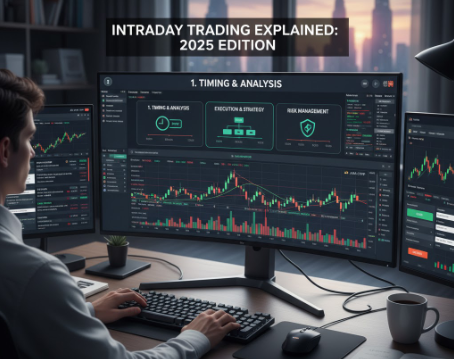- Sector -2, B Block Noida-201301
- info@tradingshastra.com
Intraday Trading Explained Step-by-Step (2025 Edition)
Intraday trading means buying and selling shares within the same trading day. Traders aim to profit from short-term price movements without holding positions overnight. It requires timing, strategy, and risk management to succeed consistently.

What Is Intraday Trading?
Definition:
Intraday trading refers to the act of buying and selling financial instruments like stocks, indices, or derivatives within the same trading day. All positions are squared off before the market closes.
In simple words, you enter a trade when you expect the price to move in your favor and exit once your target or stop level is reached — all within one market session.
Example:
If you buy 100 shares of Infosys at ₹1,500 in the morning and sell them at ₹1,520 by afternoon, the ₹20 difference per share is your trading gain (before brokerage and taxes).
Intraday vs. Delivery Trading
| Feature | Intraday Trading | Delivery Trading |
|---|---|---|
| Holding Period | Same day | Multiple days/weeks |
| Objective | Quick profits | Long-term gains |
| Risk Level | High (short-term volatility) | Moderate |
| Margin Usage | Yes | No (full capital required) |
| Ideal For | Active traders | Investors |
Intraday trading focuses on short-term market moves, whereas delivery trading suits those who prefer holding stocks for weeks or months.
Intraday Trading Time in India
The Indian stock market opens at 9:15 AM and closes at 3:30 PM.
However, not every time slot is ideal for trading.
Best Trading Hours:
9:15 AM – 10:30 AM: High volatility; best for experienced traders.
10:30 AM – 1:30 PM: Stable price movement; good for analysis-based entries.
1:30 PM – 3:00 PM: Good for breakout setups before market close.
Remember, the key is not trading all day — it’s trading at the right time with the right setup.
How to Do Intraday Trading (Step-by-Step)
If you’re a beginner, start with this structured approach:
Open a Trading and Demat Account:
Choose a SEBI-registered broker with a user-friendly interface and low brokerage charges.Select the Right Stocks:
Focus on liquid stocks with high daily volume (like Reliance, HDFC Bank, TCS).Study Market Trends:
Use technical charts to identify entry and exit zones — moving averages, RSI, and VWAP help.Plan Your Entry and Exit:
Fix your target and stop level before taking a trade. Avoid impulsive decisions.Use Limit Orders:
Avoid market orders during high volatility; they can slip in price.Apply Stop-Loss:
Always set a stop-loss to manage your trading risk.Close All Positions Before 3:20 PM:
Intraday trades automatically square off before the market closes, but manual control is safer.
Intraday Trading Strategies
Effective strategies can make or break your trading journey. Here are some popular ones:
1. Moving Average Crossover Strategy
Uses two moving averages — one short-term (e.g., 9 EMA) and one long-term (e.g., 21 EMA).
A buy signal occurs when the short EMA crosses above the long EMA; a sell signal occurs when it crosses below.
2. Breakout and Breakdown Strategy
Buy when the price breaks above a key resistance level with strong volume.
Sell (short) when it breaks below a support level.
3. VWAP Strategy
VWAP (Volume Weighted Average Price) acts as an institutional benchmark.
Traders buy when the price is above VWAP and trending upward, indicating strong buying momentum.
4. Momentum Trading
Focuses on stocks showing strong intraday movement (based on volume and volatility).
Use scanners or watchlists to identify such stocks early in the session.
Best Stocks for Intraday Trading Today
While stock selection changes daily, these characteristics help identify the right ones:
| Criteria | Description |
|---|---|
| Volume | Over 1 million shares traded daily |
| Volatility | Price range of 2–3% per day |
| News | Stocks with fresh news or results |
| Sector Movement | Stocks aligned with active sector trends |
You can check platforms like NSE India or Moneycontrol each morning for the “top intraday stocks today” based on volume and momentum.
Best Indicators and Tools for Intraday Trading
Technical indicators simplify analysis and help confirm trends.
Commonly used ones include:
RSI (Relative Strength Index): Identifies overbought or oversold conditions.
MACD (Moving Average Convergence Divergence): Tracks trend direction and momentum.
Bollinger Bands: Highlights price volatility.
VWAP: Helps determine institutional buying/selling levels.
For tools, trading apps like Zerodha Kite, Upstox, or Angel One provide easy intraday charting and alerts.
Intraday Trading Charges and Taxes
Every intraday trader should understand the costs involved.
| Component | Description |
|---|---|
| Brokerage | Charged per executed order; varies by broker |
| STT (Securities Transaction Tax) | 0.025% on sell side |
| GST | 18% on brokerage + transaction charges |
| SEBI Charges | ₹10 per crore |
| Stamp Duty | Based on state laws |
Tax Treatment:
Intraday trading profits are treated as speculative income.
They are taxed as per your income tax slab rate.
You can claim deductions for brokerage, internet, or research costs if you maintain trading records.
How to Make Money in Intraday Trading
Earning consistent returns in intraday trading requires skill and patience.
Here are key principles followed by experienced traders:
Trade with a plan. Never enter without an exit strategy.
Limit daily trades. Two to three quality trades are better than ten random ones.
Use a risk-reward ratio. A 1:2 ratio (risk ₹1 to earn ₹2) improves long-term consistency.
Maintain a trading journal. Note your trades, reasons, and outcomes.
Focus on psychology. Emotions often decide your result more than strategy.
Intraday Trading for Beginners — Tips to Start Right
Start with a demo account to learn chart patterns.
Never risk more than 2% of total capital per trade.
Avoid trading during major news events or earnings releases.
Review your performance weekly.
Focus on one or two stocks before expanding your list.
Intraday Trading Course and Learning Path
If you wish to learn intraday trading professionally, choose an institute that offers:
Live market practice sessions
Mentorship from experienced traders
Risk management modules
Practical trading simulations
For example, Trading Shastra Academy, founded by Himanshu Gurha, offers specialized programs focusing on options hedging, arbitrage, and adaptive trading. Students gain live-market exposure, a stipend internship, and structured trading discipline.
Recommended Books on Intraday Trading
How to Day Trade for a Living – Andrew Aziz
Technical Analysis of Financial Markets – John J. Murphy
Trading in the Zone – Mark Douglas
Japanese Candlestick Charting Techniques – Steve Nison
These books help build the mindset and discipline required for consistent performance.
Common Mistakes to Avoid
Trading without stop-loss
Overusing leverage
Following random tips or Telegram calls
Ignoring risk management
Trading emotionally after a loss
Remember — consistency, not excitement, makes intraday traders profitable.
Intraday Trading – FAQs
Q1. What is intraday trading and how does it work?
Intraday trading involves buying and selling stocks within the same day to profit from price fluctuations.
Q2. How much money is required to start intraday trading?
You can start with as little as ₹2,000–₹5,000, but higher capital offers flexibility for diversification.
Q3. Which is the best time for intraday trading?
Between 9:15 AM and 10:30 AM for volatility, and 1:30 PM to 3:00 PM for breakout moves.
Q4. Are intraday profits taxable?
Yes, profits are considered speculative income and taxed under your income tax slab.
Q5. What is the best indicator for intraday trading?
RSI, VWAP, and MACD are widely used for entry and exit confirmation.
Q6. Can beginners start intraday trading?
Yes, but only after proper training, risk awareness, and paper trading practice.
Q7. What are intraday trading charges in India?
Brokerage, GST, STT, SEBI fees, and stamp duty — usually less than 0.05% of trade value combined.
Q8. What is the difference between intraday and delivery trading?
Intraday means same-day trades; delivery involves holding stocks beyond one session.
Conclusion
Intraday trading is an exciting skill that can create daily opportunities when approached with discipline.
It’s less about speed and more about precision — right stock, right time, right exit.
For learners who wish to turn this into a structured career, Trading Shastra Academy in Noida provides mentorship-driven programs that focus on live-market exposure, adaptive strategies, and consistent growth in real trading environments.
Trading Shastra Academy
B-11, Sector 2, Noida – 201301
Website: www.tradingshastra.com
Email: info@tradingshastra.com
Phone: +91 9717333901
Disclaimer:
This blog is for educational purposes only. Stock market investments are subject to market risks. Please do your own research before investing.

